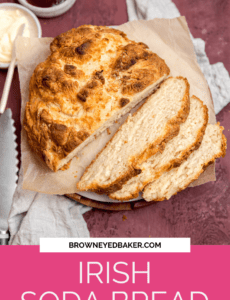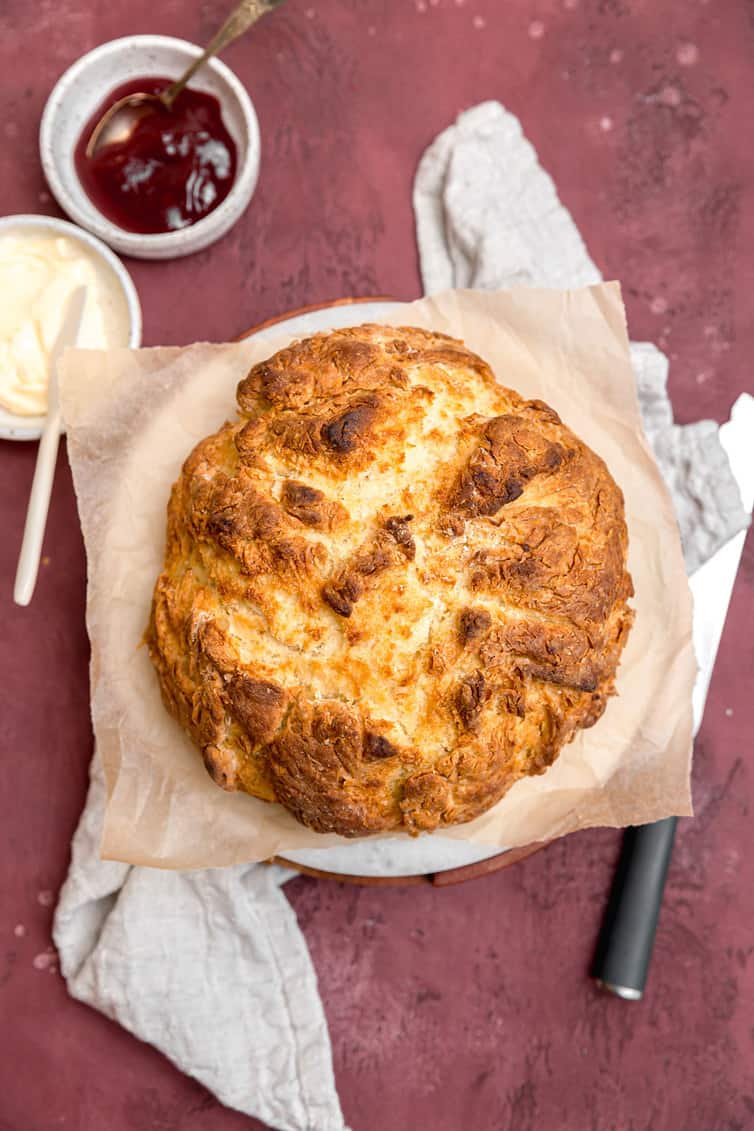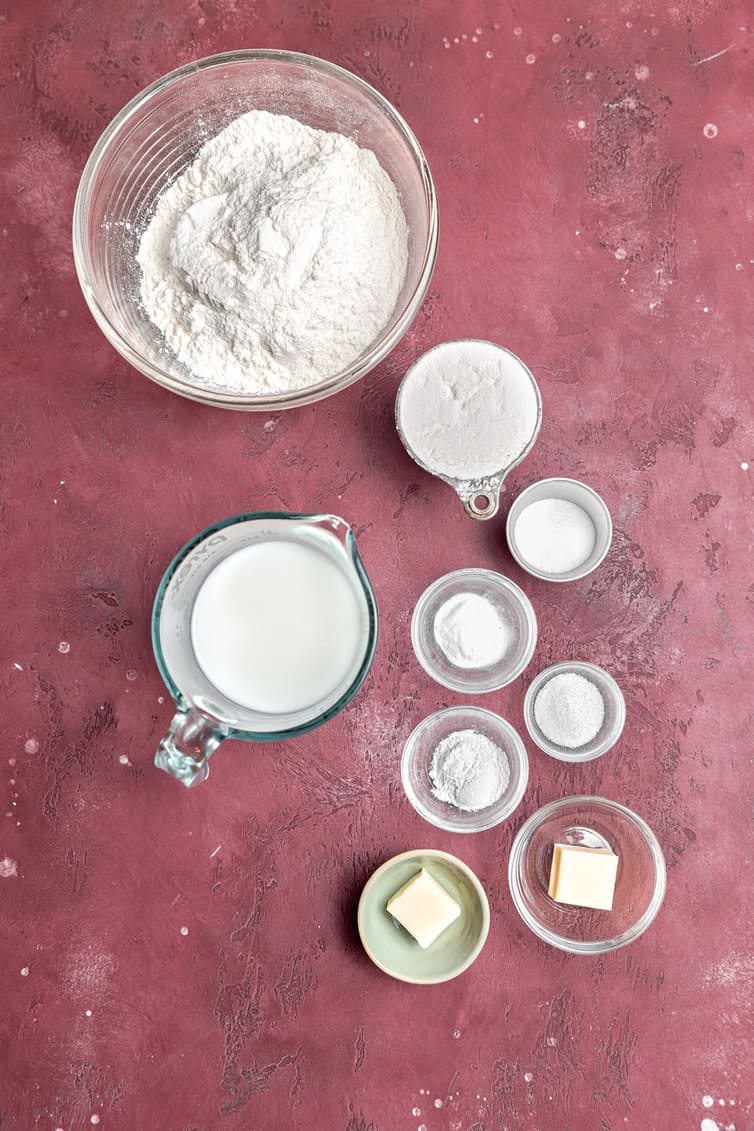Traditional Irish Soda Bread
Irish soda bread is a delicious quick bread that requires no yeast but gets its beautiful rise from a combination of baking soda and buttermilk. It has a crisp crust and a dense, tender crumb, which makes it the perfect bread for soaking up the remnants of your favorite beef stew (or just slathering in butter!). This simple soda bread can be made in just one hour and with simple ingredients!

Following the lead of the traditional Irish recipe, we are making a simple bread that comes together quickly with just a few ingredients.
We get the same crispy outer crust and tender inner crumb, but amp it up with a little richness. It's perfect for pairing with my Guiness Beef Stew on St. Patrick's Day (or any day, really)!
I’ve made a ton of variations on traditional Irish soda bread over the years – scones, brown bread, whiskey soda bread with Irish whiskey butter, and rye soda bread – however, this original classic version continues to be my absolute favorite.
It bakes up with a fabulous crisp crust and a light, tender crumb. It’s the perfect vehicle for slathering on embarrassing amounts of Kerrygold butter.
Irish soda bread history
This easy bread is considered an iconic Irish recipe, like Shepherd's Pie and corned beef.
It's an adaptation of a quick bread developed by American settlers in the 1700s. The American version was made with potash – a precursor to modern-day baking soda.
By the mid-1800s, sodium bicarbonate (the scientific name for baking soda) became commercially available in Europe, and Irish soda bread was born.
What’s in Irish soda bread
In Ireland, the traditional soda bread recipe contains only four ingredients:
- Baking soda
- Salt
- Buttermilk
- Low-Protein Flour
They are mixed together just until a rough dough forms and baked golden brown.
Save This Recipe
The resulting bread has a crispy exterior and soft, tender interior. It welcomes butter and is perfect for sopping up a delicious stew.
The Ingredients
- Flour – One of the main differences between a classic soda bread recipe and the ingredients in this one is the flour. The wheat produced in Ireland was low in protein. Being low in protein meant it didn't have enough structure to work well with yeast in bread recipes. This being said, the flour was much softer, so it did work marvelously with baking soda! These days, all-purpose flour has a higher protein than the flour in the traditional bread. As a result, we will add some cake flour, which has a lower protein count. Blending cake flour with all-purpose provides the perfect protein ratio for this bread.
- Acidity – The traditional recipe relies on buttermilk reacting with baking soda to create the leavener. This recipe boosts it with the addition of cream of tartar.
- Sugar – There's a small amount of sugar in this recipe. Not much, just two tablespoons. This helps balance out the saltiness from both the salt and baking soda.
- Butter – Butter gives the bread extra richness, more flavor, and a softer crumb.
How to make Irish soda bread
Because this is a "quick bread" recipe, the process is very easy and only takes about ten minutes!
- Prepare the Oven – Preheat your oven to 400°F. Also, adjust the rack to the middle-top position, to ensure you get a beautiful golden-brown crust.
- Prepare the Base – Break out a large mixing bowl, and dump in your dry ingredients: flours, salt, sugar, and cream of tartar. Whisk them together with a fork, and then add the softened butter. Use the back of your fork or your fingers to smash the butter into the flour until the mixture looks like coarse crumbs.
- Make the Dough – Use your fork to stir in the buttermilk just until the dough comes together. Turn it out onto a well-floured counter and gently work the dough until it's bumpy and cohesive. Form it into a 6" disc, place it onto a 12" cast iron skillet or parchment-lined baking sheet. Score the top of your loaf with an X so that it can expand in the oven.
- Bake the Bread – Place the loaf in your preheated oven and bake until golden brown and a skewer inserted into the center comes out clean. The interior should be 180°F when read with an instant-read thermometer. Baking should take 40-45 minutes. Brush the loaf with your melted butter and allow it to cool completely (about 30-40 minutes) before slicing, serving, and enjoying!
Mix-in ideas
While I love this recipe au natural, you can put tons of different spins on it! Here are some ideas for you:
Traditional Mix-ins
- 1 cup of raisins, golden raisins, or currants
- 2 teaspoons of caraway seeds
Non-Traditional Mix-Ins
- Other chopped dried fruit, such as figs or cherries
- Chopped nuts, such as walnuts or pistachios
- Cubed cheddar cheese + grated apple
- Black pepper + Parmesan cheese
- Chopped sundried tomatoes + crumbled feta
- Make it sweet with chopped dark chocolate + shredded coconut
Recipe tips and tricks for soda bread
- For the quickest bread make sure to have all your ingredients measured and in place before you begin.
- Do not knead the dough until it is smooth. Stop once it is lumpy and cohesive – about 12-14 turns. If you knead it until it's smooth, your finished bread will be tough.
- Use a cast-iron skillet for the crispiest crust. A baking sheet will work fine, but there's something magical about cast iron.
- To store the bread wrap it well in plastic wrap and keep it at room temperature for up to three days.
- Reheat slices of the bread in a toaster oven at 350 degrees F until the outside is crisp.
Irish soda bread
This quick and easy soda bread requires no yeast and is the perfect sidekick for soup night or anytime you’re craving freshly baked bread but don’t want to wait for it to rise. A must-have recipe for everyone!
If you make this recipe and love it, remember to stop back and give it a 5-star rating - it helps others find the recipe! ❤️️

Irish Soda Bread
Ingredients
- 3 cups (360 g) all-purpose flour
- 1 cup (120 g) cake flour
- 2 tablespoons granulated sugar
- 1½ teaspoons (1.5 teaspoons) baking soda
- 1½ teaspoons (1.5 teaspoons) cream of tartar
- 1½ teaspoons (1.5 teaspoons) salt
- 2 tablespoons unsalted butter, softened
- 1½ cups (360 ml) buttermilk
- 1 tablespoon unsalted butter, melted
Instructions
- Adjust an oven rack to the upper-middle position and preheat oven to 400 degrees F.
- In a large bowl, whisk together the flours, sugar, baking soda, cream of tartar, and salt. Work the softened butter into the dry ingredients with a fork or your fingertips until the texture resembles coarse crumbs.
- Add the buttermilk and stir with a fork just until the dough begins to come together. Turn out onto a floured work surface and knead just until the dough becomes cohesive and bumpy, 12 to 14 turns. (Do not knead until the dough is smooth, or the bread will turn out tough.)
- Pat the dough into a round about 6 inches in diameter and 2 inches high; place on a parchment-lined baking sheet or in a 12-inch cast iron skillet. Score the dough by cutting a cross shape on the top of the loaf.
- Bake until the loaf is golden brown and a skewer inserted into the center comes out clean, or the internal temperature reaches 180 degrees F on an instead-read thermometer, 40 to 45 minutes. Remove the loaf from the oven and brush the surface with the melted butter. Cool to room temperature before slicing, about 30 to 40 minutes. Leftovers should be wrapped in plastic wrap and stored at room temperature for up to 3 days.
Notes
- Cake Flour - You can purchase cake flour in most grocery stores or online; if you can't get it, substitute ¾ cup sifted all-purpose flour + 2 tablespoons cornstarch
- Buttermilk - This is the key to the bread's rise and phenomenal texture. If you do not have buttermilk and can't get it, use this substitution: Place 1½ tablespoons lemon juice or white vinegar in a liquid 2-cup measuring cup. Add enough whole or 2% milk to bring the mixture to 1½ cups. Stir it, then let it sit for 5 minutes before using.
- Equipment - Cast iron skillet
- Mix-Ins - See the list above for both traditional and non-traditional mix-in ideas.
- Freezing Instructions - You can freeze the entire loaf or individual slices. Cool the bread completely, then wrap tightly in plastic wrap and place in a freezer-safe zip-top bag. Freeze for up to 3 months; thaw in the refrigerator or at room temperature.
Did you make this recipe?
Leave a review below, then snap a picture and tag @thebrowneyedbaker on Instagram so I can see it!
Photography by Ari Laing











This may not fit the bill for a traditional Irish soda bread, but everyone who I shared my batch of this bread with said it was the best soda bread they’d ever had. This recipe will be a staple in our kitchen going forward. (Surely this would all be considered blasphemy! My ancestors are surely turning in their graves right now!! They can fight me. They have no idea what they’re missing.) I also lightly salted the top before baking. And dare I even admit, I finely grated some Kerrygold Skellig cheddar into the mix?! Damn near put myself over the edge. Thank you for sharing. Looking forward to trying more of your recipes!
Hiya petal thank you for your home made soda bread ingredients was just wondering about the oven temperature most ovens are different just like the gas oven what is the oven settings for fan ovens please thank you so much please stay safe and thank you again petal happy new year to you petal x
Can I use dry buttermilk (e.g. SACO Cultured Buttermilk Blend) in place of regular buttermilk without sacrificing taste or texture?
I haven’t used that in this particular recipes, but I have used it in others and it worked wonderfully! I would say give it a shot!
Loved this recipe! Made Irish Soda Bread for the first time March 2020 (guess why). Knew BEB recipes were always good, so I didn’t bother searching elsewhere. It was a great addition to the corned beef etc, especially for mopping up. I rarelly get around to after-action reports on recipes, but this one is a winner, and so easy.
I made this for St. Patrick’s Day and it was really good!
Made this today. Followed your directions. Added currants into the mix and sparkling sugar across the top. It came out great. Everyone loved it. Very nice soda bread.
I was just reading through the comments so I wasn’t redundant. I make a similar traditional/classic recipe that has been passed down to me through the generations that adds raisins and caraway. The warm slice with Irish butter has inspired me to make it this morning. I just wanted to add you say you cut an X on top…I’ve always been taught that it’s a cross and you say “in the name of the Father, Son and the Holy Spirit as you do it. 🤷🏼♀️ Just thought it was interesting. ☘️ Thanks for posting this lovely recipe.
Made it for dinner tonight. Loved it. Definitely a keeper and will be making it at least once a week!
I have been looking for a good grasshopper pie recipe for a long time.This one is delicious. Love you recipes.
Do you grease the cast iron pan before baking?
Do you preheat Cast iron pan ?
Hi Michelle. I just made your Irish Soda Bread today. My husband and myself, just had a nice warm slice with Kerrygold whiskey butter. It is delicious. I make soda bread a lot. Your recipe and mine are different with different results. I like them both. It’s fun to change things around and put a new spin on what you know. Or as I say to my husband when I move the furniture around or change the kitchen cabinets, “Change is good.” Thanks for yet another tasty and great recipe
LInda
P.S. I made your bourbon cake and it was a hit. Now, I am going to make it again tonight with Irish whiskey.
Classic or Traditional Irish Soda Bread does NOT contain eggs, raisins, sugar, butter, etc. Just four ingredients: flour, baking soda, salt and buttermilk. See The Society for the Preservation of Irish Soda Bread., http://www.sodabread.info/menu/
The whole point of soda bread was the simplicity and availability of the ingredients.
I suggest you remove the reference to “classic” because, it’s simply not. The addition of things like raisins, sugar, etc. is more of an American thing.
Catherine is correct to my teaching about soda bread. That is the way I was taught, too. Too many people have never been in Ireland or have not been taught by Irish bakers or have the old recipes that have been handed down from older bakers. My brisket and a piece of bacon(fatty cured pork) is cooked (simmered) in a beer with cabbage, potatoes, and carrots. The harshness of the lives of the Irish made the old recipes what they are. Newer recipes had been developed with the glitz of added ingredients and should be described as modern recipes so as not to confuse people who like the sweeter and more modern tastes of added fruits and even nuts.
Excuse me, I come back just to say, concerning the cream of tartar : this is an acid agent, and we know that acidity is necessary in combination with bread soda (baking soda) to let it react. But you already have the acidity with the buttermilk. I made your recipe without the cream of tartar and it worked perfectly (so don’t worry if you have no cream of tartar in your kitchen !)
And concernig the butter, I was confusing with “fat”, so you were right when saying that in hard times, butter (I mean real butter, not lard or other fat) was a luxury ingredient
But what I still don’t understand is : why unsalted butter…
I don’t know if this recipe is “purely” irish or not, as said someone, but sure butter in irish soda bread mau ALSO be irish. Now you may add butter or not (some do, some dont’, personnaly I don’t) but I agree that butter was part of the “fats” that were possible to afford in hard times. What I don’t understand is : why “unsalted” ??? Irish butter, s salted (as ours, in Brittany, hmmmm, too good !!!) And what I find no use is crema of tartra. But it’s nice to get different recipes, so we can try each one and then, mix and make our own. So thanks a lot for giving yours. Emsi, from Brittany
Turned out great! I used my biscuit technique of grating frozen butter with a cheese grater instead of cutting in – just seems quicker to me. I left out the one cup of cake flour until turning out and kneading (in retrospect, I think I’d leave out one cup of the AP flour for the turning instead), and like biscuits, I barely worked the dough. With this loaf, I do wish I had kneaded just a little bit more than I do with my biscuit technique; 12-14 turns mentioned in the recipe didn’t seem to be quite enough, so when cutting with a knife, the loaf isn’t quite supported enough in places and a few pieces would break off. I would definitely knead a bit more to make the loaf more cohesive, but my biscuit technique starts the kneading process with a very wet dough, almost a batter. The flavor, crumb, texture, baking time and temp etc was all perfect!
Ivey,
I’ve been trying to make “great” biscuits seems like FOREVER! Lol! Never have had a really good recipe, so when I read all of your comments about your “wonderful” biscuit techniques I want MORE! Will you please share that?? FYI, I LOVE crispy (“crunchy”!) on outside and soft on inside!!!
Thank you in advance!!
Annieb
Terrific
Thankyou👍💖😄
Hands down, the greatest soda bread I’ve ever had , let alone made! I didn’t have cream of tartar, so used baking powder with an extra 1/4 tsp of soda. Fantastic recipe, thank you!
P.s. I made it to take to st pattys corned beef and cabbage @ a friend’s. I made a half batch with raisins and caraway seeds (because we couldn’t wait!) Exquisite!
Had to add some extra butter to get more of a coarse crumbs texture, but the bread still turned out great. Also substituted milk with lemon juice for the buttermilk.
The intro refers to slicing a warm piece right out of the oven and the total time is 1 hour but the recipe says to let it rest 30 to 40 minutes after baking. Does it need the resting time to finish baking or can it be eaten right away? Thanks!
Hi Diane, As with all bread, it’s best to let it cool to room temperature before slicing so it sets up properly, but sometimes I just dig in because warm bread is so wonderful!